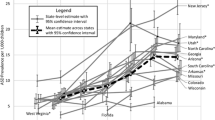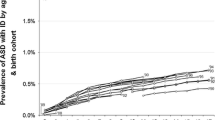Abstract
Change over time in the age and number of children registered for autism-specific funding was examined, prior to and following introduction of the revised diagnostic criteria (the Diagnostic and Statistical Manual of Mental Disorders—fifth edition; DSM-5). De-identified data for 32,199 children aged under 7 years between 2010 and 2015 was utilised. Fluctuations were evident in the frequency and age of diagnoses, with slight increases in age of diagnosis corresponding with increases in frequency of diagnoses. The incidence of autism increased from 2010 to 2013, and then plateaued to 2015. A significant trend-relative reduction in the number of children registered to receive autism-specific funding was evident post 2013, suggesting the more stringent DSM-5 criteria may have curbed the trend of increasing diagnoses over time.



Similar content being viewed by others
Notes
This data item included 8.8 % missing data.
References
American Psychiatric Association. (1994). Diagnostic and statistical manual of mental disorders, fourth edition (DSM-IV). Washington, DC: American Psychiatric Association.
American Psychiatric Association. (2000). Diagnostic and statistical manual of mental disorders, fourth edition, text revision (DSM-IV-TR). Washington, DC: American Psychiatric Association.
American Psychiatric Association. (2013). Diagnostic and statistical manual of mental disorders, fifth edition (DSM-5). Washington, DC: American Psychiatric Association.
Barbaro, J., & Dissanayake, C. (2016). Diagnostic stability of autism spectrum disorder in toddlers prospectively identified in a community-based setting: Behavioural characteristics and predictors of change over time. Autism. doi:10.1177/1362361316654084.
Barton, M. L., Robins, D. L., Jashar, D., Brennan, L., & Fein, D. (2013). Sensitivity and specificity of proposed DSM-5 criteria for autism spectrum disorder in toddlers. Journal of Autism and Developmental Disorders, 43(5), 1184–1195. doi:10.1007/s10803-013-1817-8.
Bennett, M., & Goodall, E. (2016). A meta-analysis of DSM-5 autism diagnoses in relation to DSM-IV and DSM-IV-TR. Review Journal of Autism and Developmental Disorders, 3(2), 119–124. doi:10.1007/s40489-016-0070-4.
Bent, C. A., Dissanayake, C., & Barbaro, J. (2015). Mapping the diagnosis of autism spectrum disorders in children aged under 7 years in Australia, 2010–2012. The Medical Journal of Australia, 202(6), 317–320. doi:10.5694/mja14.00328.
Centers for Disease Control and Prevention. (2007). Prevalence of autism spectrum disorder—autism and developmental disabilities monitoring network, six sites, United States, 2000. MMWR, 56(1), 1–11. Retrieved from http://www.cdc.gov/mmwr/PDF/ss/ss5601.pdf.
Centers for Disease Control and Prevention. (2014). Prevalence of autism spectrum disorder among children aged 8 years-autism and developmental disabilities monitoring network, 11 sites, United States, 2010. MMWR, 63(2), 1–21. Retrieved from http://www.ncbi.nlm.nih.gov/pubmed/24670961.
Christensen, D., Baio, J., Van Naarden Braun, K., Bilder, D., Charles, J., Constantino, J., … Yeargin-Allsopp, M. (2016). Prevalence and characteristics of autism spectrum disorder among children aged 8 years—Autism and Developmental Disabilities Monitoring Network, 11 Sites, United States, 2012. MMWR, 65(3), 1–23. Retrieved from http://www.cdc.gov/mmwr/volumes/65/ss/ss6503a1.htm.
Daniels, A. M., & Mandell, D. S. (2014). Explaining differences in age at autism spectrum disorder diagnosis: A critical review. Autism: The International Journal of Research and Practice, 18(5), 583–597. doi:10.1177/1362361313480277.
Daniels, A. M., Rosenberg, R. E., Law, J. K., Lord, C., Kaufmann, W. E., & Law, P. A. (2011). Stability of initial autism spectrum disorder diagnoses in community settings. Journal of Autism and Developmental Disorders, 41(1), 110–121. doi:10.1007/s10803-010-1031-x.
Flanagan, H. E., Perry, A., & Freeman, N. L. (2012). Effectiveness of large-scale community-based intensive behavioral intervention: A waitlist comparison study exploring outcomes and predictors. Research in Autism Spectrum Disorders, 6(2), 673–682. doi:10.1016/j.rasd.2011.09.011.
Fombonne, E., Quirke, S., & Hagen, A. (2009). Prevalence and interpretation of recent trends in rates of pervasive developmental disorders. McGill Journal of Medicine, 12(2). Retrieved from http://www.ncbi.nlm.nih.gov/pmc/articles/PMC2997266/.
Gibbs, V., Aldridge, F., Chandler, F., Witzlsperger, E., & Smith, K. (2012). Brief report: An exploratory study comparing diagnostic outcomes for autism spectrum disorders under DSM-IV-TR with the proposed DSM-5 revision. Journal of Autism and Developmental Disorders, 42(8), 1750–1756. doi:10.1007/s10803-012-1560-6.
Huerta, M., Bishop, S. L., Duncan, A., Hus, V., & Lord, C. (2012). Application of DSM-5 criteria for autism spectrum disorder to three samples of children with DSM-IV diagnoses of pervasive developmental disorders. American Journal of Psychiatry, 169, 1056–1064.
Idring, S., Lundberg, M., Sturm, H., Dalman, C., Gumpert, C., Rai, D., … Magnusson, C. (2014). Changes in prevalence of autism spectrum disorders in 2001–2011: Findings from the Stockholm Youth Cohort. Journal of Autism and Developmental Disorders. doi:10.1007/s10803-014-2336-y.
Kanner, L. (1943). Autistic disturbances of affective contact. Nervous Child, 2, 217–250.
Kim, Y. S., Leventhal, B. L., Koh, Y.-J., Fombonne, E., Laska, E., Lim, E.-C., … Grinker, R. R. (2011). Prevalence of autism spectrum disorders in a total population sample. American Journal of Psychiatry, 168(9), 904–912. doi:10.1176/appi.ajp.2011.10101532.
Lord, C. (2012). A multisite study of the clinical diagnosis of different autism spectrum disorders. Archives of General Psychiatry, 69(3), 306. doi:10.1001/archgenpsychiatry.2011.148.
Macintosh, K. E., & Dissanayake, C. (2004). Annotation: The similarities and differences between autistic disorder and Asperger’s disorder: A review of the empirical evidence. Journal of Child Psychology and Psychiatry, 45(3), 421–434.
Maenner, M. J., Rice, C. E., Arneson, C. L., Cunniff, C., Schieve, L. A., Carpenter, L. A., … Durkin, M. S. (2014). Potential impact of DSM-5 criteria on autism spectrum disorder prevalence estimates. Journal of the American Academy of Psychiatry, 71(3), 292. doi:10.1001/jamapsychiatry.2013.3893.
Mahjouri, S., & Lord, C. E. (2012). What the DSM-5 portends for research, diagnosis, and treatment of autism spectrum disorders. Current Psychiatry Reports, 14(6), 739–747. doi:10.1007/s11920-012-0327-2.
Matson, J. L., Hattier, M. A., & Williams, L. W. (2012). How does relaxing the algorithm for autism affect DSM-V prevalence rates? Journal of Autism and Developmental Disorders, 42(8), 1549–1556. doi:10.1007/s10803-012-1582-0.
Matson, J. L., Kozlowski, A. M., Hattier, M. A., Horovitz, M., & Sipes, M. (2012). DSM-IV vs DSM-5 diagnostic criteria for toddlers with. Autism: Developmental Neurorehabilitation, 15(3), 185–190. doi:10.3109/17518423.2012.672341.
Mattila, M.-L., Kielinen, M., Linna, S.-L., Jussila, K., Ebeling, H., Bloigu, R., … Moilanen, I. (2011). Autism spectrum disorders according to DSM-IV-TR and comparison with DSM-5 draft criteria: An epidemiological study. Journal of the American Academy of Child & Adolescent Psychiatry, 50(6), 583–592.
Mayes, S. D., Calhoun, S. L., Murray, M. J., Pearl, A., Black, A., & Tierney, C. D. (2014). Final DSM-5 under-identifies mild autism spectrum disorder: Agreement between the DSM-5, CARS, CASD, and clinical diagnoses. Research in Autism Spectrum Disorders, 8(2), 68–73. doi:10.1016/j.rasd.2013.11.002.
McPartland, J. C., Reichow, B., & Volkmar, F. R. (2012). Sensitivity and specificity of proposed DSM-5 diagnostic criteria for autism spectrum disorder. Journal of the American Academy of Child & Adolescent Psychiatry, 51(4), 368–383. doi:10.1016/j.jaac.2012.01.007.
Ozonoff, S., Young, G. S., Landa, R. J., Brian, J., Bryson, S., Charman, T., … Iosif, A.-M. (2015). Diagnostic stability in young children at risk for autism spectrum disorder: a baby siblings research consortium study. Journal of Child Psychology and Psychiatry. doi:10.1111/jcpp.12421.
Perry, A., Blacklock, K., & Dunn Geier, J. (2013). The relative importance of age and IQ as predictors of outcomes in intensive behavioral intervention. Research in Autism Spectrum Disorders, 7(9), 1142–1150. doi:10.1016/j.rasd.2013.06.004.
Randall, M., Sciberras, E., Brignell, A., Ihsen, E., Efron, D., Dissanayake, C., & Williams, K. (2016). Autism spectrum disorder: Presentation and prevalence in a nationally representative Australian sample. Australian and New Zealand Journal of Psychiatry, 50(3), 243–253.
Smith, I. C., Reichow, B., & Volkmar, F. R. (2015). The effects of DSM-5 criteria on number of individuals diagnosed with autism spectrum disorder: A systematic review. Journal of Autism and Developmental Disorders, 45(8), 2541–2552. doi:10.1007/s10803-015-2423-8.
Swedo, S. E., Baird, G., Cook, E. H., Happé, F. G., Harris, J. C., Kaufmann, W. E., … Wright, H. H. (2012). Commentary from the DSM-5 workgroup on neurodevelopmental disorders. Journal of the American Academy of Child & Adolescent Psychiatry, 51(4), 347–349.
Vivanti, G., Hudry, K., Trembath, D., Barbaro, J., Richdale, A., & Dissanayake, C. (2013). Towards the DSM-5 criteria for autism: Clinical, cultural, and research implications: DSM-5 criteria for autism. Australian Psychologist, 48(4), 258–261. doi:10.1111/ap.12008.
Volkmar, F. R., & McPartland, J. C. (2014). From Kanner to DSM-5: Autism as an evolving diagnostic concept. Annual Review of Clinical Psychology, 10(1), 193–212. doi:10.1146/annurev-clinpsy-032813-153710.
Volkmar, F. R., & Reichow, B. (2013). Autism in DSM-5: Progress and challenges. Molecular Autism, 4(1), 13.
Williams, K., Glasson, E. J., Wray, J., Tuck, M., Helmer, M., Bower, C. I., & Mellis, C. M. (2005). Incidence of autism spectrum disorders in children in two Australian states. Medical Journal of Australia, 182(3), 108–111.
Williams, K., MacDermott, S., Ridley, G., Glasson, E. J., & Wray, J. A. (2008). The prevalence of autism in Australia. Can it be established from existing data? Journal of Paediatrics and Child Health, 44, 504–510.
Young, R. L., & Rodi, M. L. (2013). Redefining autism spectrum disorder using DSM-5: The implications of the proposed DSM-5 criteria for autism spectrum disorders. Journal of Autism and Developmental Disorders, 44(4), 758–765. doi:10.1007/s10803-013-1927-3.
Acknowledgments
The first author was supported by a La Trobe University Postgraduate Research Scholarship while conducting this project. The authors would also like to acknowledge the Australian Government Department of Social Services, who provided the data for analysis.
Author Contributions
CB participated in the design of the study, conducted the analyses and drafted the manuscript. CD and JB participated in the design of the study, advised on the interpretation of data and reviewed the manuscript. All authors read and approved the final manuscript.
Author information
Authors and Affiliations
Corresponding author
Ethics declarations
Conflict of Interest
Catherine Anne Bent declares that she has no conflict of interest. Josephine Barbaro declares that she has no conflict of interest. Cheryl Dissanayake declares that she has no conflict of interest.
Ethical Approval
All procedures performed in studies involving human participants were in accordance with the ethical standards of the institutional and/or national research committee and with the 1964 Helsinki declaration and its later amendments or comparable ethical standards.
Informed Consent
For this type of study formal consent is not required.
Rights and permissions
About this article
Cite this article
Bent, C.A., Barbaro, J. & Dissanayake, C. Change in Autism Diagnoses Prior to and Following the Introduction of DSM-5. J Autism Dev Disord 47, 163–171 (2017). https://doi.org/10.1007/s10803-016-2942-y
Published:
Issue Date:
DOI: https://doi.org/10.1007/s10803-016-2942-y




